Manufacturing technology for building materials and products. Рубрика в журнале - Nanotechnologies in Construction: A Scientific Internet-Journal
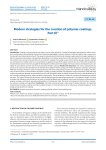
Modern strategies for the creation of polymer coatings. Part III
Статья научная
Introduction. Coatings on hard materials are widely used in many industries. Coating technologies help prevent or reduce corrosion, contamination and biofouling, chemical and structural degradation, and wear and tear of external surfaces due to exposure to the elements and natural environments. The range of materials used for functional coatings is quite wide: from organic polymers to hybrid composites and inorganic nanoparticles, depending on the desired properties and functionality of the final product. Despite the excellent anti-corrosion characteristics of non-polymer coatings, their usage causes environmental damage. Organic coatings are among the most widely used. Such compositions are applied in liquid form; organic solvents are one of the main components. Environmental concerns have encouraged the development of alternative technologies. The main areas for development are availability of raw materials and the cost of environmentally friendly coatings. Results and discussion. The review substantiates the relevance of research on the development of multifunctional polymer-based coatings. The market for polymer coatings is presented. Methods of surface protection, types of coatings formed, their main components, features of the formation of coatings, the influence of various factors on the formation of polymer coatings, including methods of preparation and pre-treatment of the protected surface are presented. Methods for preventing corrosion are discussed in detail, as well as the main directions in the development of anti-corrosion coatings based on various protective mechanisms. The characteristics of the main components of protective coatings are given. The issue of destruction of polymer coatings depending on the operating environment is considered in detail. The types of media, their influence and mechanisms of action on protected objects are considered. Factors and mechanisms of destruction of polymer coatings, methods for preventing degradation of coatings are listed. The latest technologies for the formation of protective polymer coatings are highlighted. Conclusion. Currently, coatings provide a wide range of quality indicators. An important characteristic of modern coatings is minimal negative impact on the environment, which requires an integrated approach to the design and production of coatings.
Бесплатно
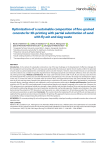
Статья научная
Introduction. In the context of sustainable construction, one of the key challenges is the development of effective strategies for the management and recycling of fly ash and slag waste produced by thermal power plants. Recent studies confirm the potential of such waste as a partial substitute for conventional sand in concrete mixtures. However, most research focuses on conventional concrete and does not consider the specific requirements for rheological properties and interlayer adhesion, which are critical for 3D printing technology. Methods and Materials. The study used Portland cement CEM I 42.5N, fly ash and slag waste from the Ust-Kamenogorsk TPP, crushed sand, and the MasterGlenium superplasticizer. The concrete mix design was developed in stages: a base mix, a control mix (with an increased water-to-cement ratio), and experimental mixes with 25% and 50% sand replacement by fly ash and slag waste. Samples were printed using a construction 3D printer (model S-6045) and tested for compressive strength, density, interlayer adhesion, and subjected to micro and nanostructural analysis. Results and Discussion. Experimental mixtures with 25% and 50% sand replacement showed reduced density and strength compared to the control mix. However, the 25% replacement mix maintained satisfactory strength, shape stability, and interlayer bonding. Micro and nanostructural analysis confirmed the relationship between structural compaction and physical-mechanical properties. Despite some limitations, the study demonstrated the potential of TPP-derived ash and slag waste as a viable component in 3D printing, provided the composition and extrusion parameters are optimized. Conclusion. The results indicate that replacing 25% of sand with fly ash and slag waste is optimal for fine-grained concrete mixtures intended for 3D printing. This approach improves resource efficiency and environmental sustainability without compromising the performance of the final products.
Бесплатно
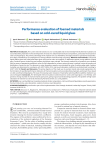
Performance evaluation of foamed materials based on cold-cured liquid glass
Статья научная
Introduction. The current trend of transition to non-combustible and environmentally friendly thermal insulation and sound-absorbing materials involves development of research to obtain foamed silicate compositions, particularly those based on cold-cured liquid glass. The primary advantage of this material is its eco-friendliness throughout both its operational and production stages, facilitated by the employment of energy-efficient manufacturing technology. Materials and methods. Cold-cured liquid sodium glass and cullet-based foam glass were used as main raw materials. To determine optimal curing additive of liquid glass, Portland cement, slaked lime and sodium ethylsilicate were selected. The thermal conductivity of materials was evaluated with by means of appropriate coefficient, value of which depended on volume content of pores in material, nature of porosity and distribution of pores by size. The decrease in water absorption capacity was estimated by value of wetting edge angle. Sorption humidity was determined in accordance with GOST 24816-2014, and sound absorption coefficient was determined according to GOST 16297-80. Results and discussion. The prime objective of this study was to examine trends and provide explanations for the formation of specified performance indicators of thermal insulation and sound-absorbing materials, particularly those based on cold-cured foamed liquid glass. The issue of increasing water resistance of material by selecting effective additive-hardener was also investigated. Conclusion. The developed thermal insulation material based on cold-cured liquid glass is eco-friendly, with presence of large number of small and mainly open pores, giving it good sound-absorbing properties. The problem of high-water absorption of material was solved by introducing Portland cement as a curing additive.
Бесплатно
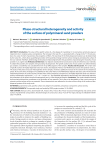
Phase-structural heterogeneity and activity of the surface of polymineral sand powders
Статья научная
Introduction. The value of the specific surface (Ssp), the degree of crystallinity (С, %) and surface activity (ks) plays an important role in creating various compositions. The increase in the size of Ssp is associated with a change in the “С” of rock powders, the value of which characterizes the properties of fillers. The reactivity of the finely dispersed material can be determined by the value of ks, which allows quantifying transition of the potential energy into free surface energy by activating the surface of the raw material. Therefore, determining the functional relationship between the parameters characterizing the reactivity of rock powders is an urgent task. Methods and Materials. Four deposits of polymineral construction sands are selected as raw materials. To obtain fine powders, the samples were ground by dry dispersion. The specific surface area of rock systems was determined by gas sorption. Crystallinity was calculated from the X-ray diffractogram of the samples. Results and Discussion. The certain sizes of specific surfaces for highly dispersed rocks have shown, that deposits “Kenica” and “Nekhtskoye” possess the greatest values Ssp. The study of the phase-structural heterogeneity of the samples, showed a significant increase of the content of the amorphous phase. At the same time, the degree of crystallinity for the sands “Kenica” and “Nekhtskoye” deposits decreases 25%. The functional relationship between the surface activity and the shares of the amorphous component (c) for highly dispersed sands was characterized by mathematical expression ks = 21•10–6•c+0,58•10–6. The identified dependence demonstrates the relationship between the parameters of the phase-structural heterogeneity and ks of fine-dispersed samples. Conclusion. The results obtained showed that mechanical dispersion contributes to the activation of raw materials. This is due to the breakability of the crystal structure of minerals and the texture of the raw materials. These characteristics are reflected in the value of the activity of the surface of finedispersed systems of the rocky rocks.
Бесплатно
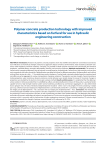
Статья научная
Introduction. Research of polymer concrete properties show that it differs favorably from conventional concrete by such indicators as mechanical strength, resistance to aggressive impact of various environments, water resistance, abrasion resistance, water-repellency and frost resistance. Currently, it is possible to obtain polymer concrete with characteristic and chemical properties –specified density, strength, deformability, ductility, and corrosion resistance. Methods and materials. The research is carried out by comparing laboratory tests of polymer concrete based on furfural binder. Furfural has a high reactivity and can form resin compounds with many chemicals. Diphenylamine was added to furfural in different proportions. Benzenesulfonic acid, sulfuric acid and their mixture at a ratio – 1:1 by weight were used as hardeners. Crushed sand or ground andesite based on nanostructured microfiller served as aggregate for various compositions of polymer solutions. The polymer concrete strength, chemical resistance, lasting properties, water resistance, abrasion resistance, metal adhesion were tested during the research. Structural changes in properties were studied by the electron microscopic analysis method. Results and discussion. It is established that the diphenylamine solution in furfural, provided that it is solidified by sulfuric acid, benzolsulfoacid or mixture of these acids, is a polymer binder capable to form a high-strength material under normal hardening conditions by acid-resistant aggregates. It is also determined that to prepare resin, the ratio of furfural and diphenylamine should be within 1:0.5–0.3 by weight. The resin containing 1 weight part (w.p.) of furfural and 0.5 weight part of diphenylamine is conventionally named FD-1; containing 1 weight part of furfural and 0.4 weight part of diphenylamine – FD-2 and resin with 0.3 weight part of diphenylamine – FD-3. Conclusion. The introduction of nanostructured microfiller into the polymer concrete composition could save expensive resin. Comparison of the technologies for producing FD resin and polymer concrete, as well as preliminary test data of the studied materials, can determine the possible technical and economic advantages of polymer concrete based on FD resin over the polymer concrete based on FA (furfurolacetone) monomer which is currently used in construction of hydro-engineering structures. Polymer concrete based on FD resin has high strength and exceeds the strength of polymer concrete based on FA monomer by 20–25%.
Бесплатно
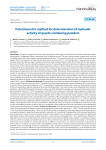
Potentiometric method for determination of hydraulic activity of quartzcontaining powders
Статья научная
Introduction. An important aspect of concrete mixture preparation technology is the exploration of methods to effectively utilize the properties of aggregates (fillers) in hardening multi-component systems. The most common binder composition is a mixture of a binder system with crushed quartz-containing polymineral sand. It is known that micro silica is classified as an active mineral additive (filler), the properties of which are characterized by the amount of Ca2+ ions absorbed from a saturated lime solution. Literature sources describe two types of analytical methods for determining pozzolanic activity. The first type that trace the change in the content of Ca(OH)2 over time during the pozzolanic reaction. The second type that aim to determine the physical and mechanical characteristics of the material under study. These characteristics reflect its ability to bind free calcium oxide into stable hydrate compounds. Previously applicability of the potentiometric method of analysis using an ion-selective electrode with pCa-function was demonstrated for the assessment of pozzolanic activity of highly dispersed materials. It should be noted to note that this electrochemical method of analysis which is functionally related to the concentration of the determined component in the tested solution, is very efficient in terms of expressiveness and labour intensity. The objective of the research is to validate the method for micro silica systems obtained by mechanical grinding of raw materials of polymineral sands from different deposits. The experiments were conducted using sands from the Arkhangelsk region deposits. The quartz sand (QS) was chosen as a reference object to establish the nature of change in the functional relationship of the measured potential of the electrode system from the volume of added Ca(OH)2 solution. Methods and Materials. The polymineral sand of the Krasnoflotsky-West deposit is categorised as alluvialmarine modern Quaternary sediments (am IV). The sand of the Kholmogorskoye deposit is quartz-feldspathic sand, which belongs to alluvial modern Quaternary sediments (a IV). The mineralogical composition of polymineral sands was determined by means of the semi-quantitative method, utilising the binocular microscope MBS-1. Fine sand powders were obtained by dry mechanical grinding in a Retsch PM100 planetary. The specific surface area of the obtained fine powders was measured by the Kozeny-Karman gas permeability method on a PSKh-10a apparatus. The potentiometric analysis was conducted using an apparatus comprising an electrode pair, consisting of a measuring electrode with pCa-function and a reference electrode connected to an Expert-001-3.0.1 ionometer. The reaction system was stirred using a magnetic stirrer. In order to ascertain the sorption capacity of silica-containing raw materials, a lime solution with a concentration and a suspension of fine sand powders were prepared in advance. Concurrently, the EMF (potential) of the system was measured, with constant stirring. The concentration of calcium ions, Cact, was then calculated based on the previously established calibration dependence, using the potential values (mV) obtained. In order to determine the activity of fine mineral powders of silica, the dependence between the values of the given concentration of calcium ions in lime solution when adding a certain volume of lime to the suspension of the studied sands and the concentration values obtained by potentiometric measurements was plotted. Results and Discussion. The obtained powders of quartz-containing polymineral sands, which had been finely dispersed, had the following specific surface values: quartz sand – 1020±31 m2/kg, Krasnoflotsky West – 465±14 m2/kg and Kholmogorskoye – 450±14 m2/kg. The given data on the specific surface of powders of natural origin allow for a comparative analysis of experimental potentiometric measurements. Concurrently, the dependence of the measured potential on the concentration of calcium ions in the solution for quartz sand suspension can be utilised as a reference, given the significantly high specific surface of the powder, thereby resulting in a more pronounced dependence E = f(Vadd). Relationship obtained the dependence of the measured potential of the electrode system on the volume of added Ca(OH)2 solution in a suspension of quartz sand (as a reference sample) and distilled water (as an idle experiment) shows that the nature of the change in the functional relationship of the analysed two samples (QS and H2O) is different. Concurrently, it can be observed that the incorporation of a lime solution into water (in accordance with the anticipated outcome) results in a nearly constant augmentation in the measured potential values, the magnitude of which is proportional to –lgCCa. Change of potential of electrode pair in suspension of quartz sand powder has character different from that mentioned above for water.
Бесплатно
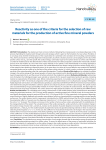
Статья научная
Introduction. The simplest and most common method of obtaining fine mineral powder is mechanical dispersion. In the process of grinding the material went through some work (energy), which is spent on the formation of a new surface. Therefore, it is not always clear whether the destruction of the crystal lattice of a solid lead to the activation of the resulting crushed material. Thus, the key characteristics of finely dispersed mineral powders, by which activation processes can be judged, are the value of the specific surface area (Ssp) and the specific free surface energy, numerically equal to the surface tension (σ) of the solid. Therefore, a number of models based on the determination of these characteristics have been proposed to estimate the mechanical activation process of the raw material. So, one of the most correct methods, in our opinion, is the method based on an energy approach to the evaluation of mechanical activation processes. This model determines the relative change in the free surface energy (ΔES/ES0) of the material when obtaining a dispersed system. At the same time, the choice of the most effective raw materials for obtaining composite binders can be carried out on the basis of the surface activity criterion (ks), which is used as a criterion characterizing the reactivity of fine mineral powders after their mechanical disintegration. Therefore, the aim of this study was to calculate the relative change in the surface energy of fine mineral powders of various raw materials and to identify possible functional relationship between the parameter ΔES/ES0 and the amount of surface activity for the studied rock systems. Methods and Materials. Sedimentary rocks formations the Arkhangelsk region were selected as materials for the research: polymineral sand and saponite-containing material (a representative of bentonite clays). Before conducting experiments, rock samples were brought to a constant mass at a temperature of 105оС. The chemical composition of the samples was determined on an X-ray fluorescence analyzer “Metexpert”. Highly dispersed rock fractions were obtained by dry grinding on a planetary ball mill Retsch PM100. The dimensional characteristics were determined using the DelsaNano submicron particle size analyzer by photon correlation spectroscopy. The specific surface area was determined by the gas permeability method on the PSX-10 device. To calculate the surface tension, the edge angle was measured on the “Easy Drop” installation. The surface tension for highly dispersed samples was calculated by the OWRK method. Results and Discussion. The calculated macro-energy characteristics of the studied samples have showed that the atomization energy for polymineral sand was 1910.72 kJ/mol, and for saponite–containing material was 1826.94 kJ/mol. At the same time, the mass specific atomization energy for sand and SCM are 30.41●103 kJ/kg and 26.94●103 kJ/kg, respectively. In the process of dispersion, several fractions of highly dispersed rock powders were obtained, which are characterized by an average particle size and specific surface area. The surface tension (and its components) calculated by the OWRK method showed that for all the samples studied, the polarization effect (σS P) prevails over the dispersion interaction (σS D). At the same time, as Ssp increases, the numerical value of the ratio σS P/σS D increases. This indicates an increase in the number of active surface centers associated with the redistribution of the energy potential of the system. The calculated values of free surface energy (ЕS), surface activity (ks) and the relative change in free surface energy showed, that ks and ΔES/ES0 increase as the duration of powder dispersion increases.The obtained functional dependences ks = f(ΔES/ES0) for the studied samples of polymineral sand and saponitecontaining material are linear in nature and obey the general equation у = a●x + b. In this case, the coefficient “a” characterizes the dynamics of changes in the reactivity of the material with an increase in the duration of mechanical grinding, and the parameter “b” – reactivity in the microstate. Comparison of the coefficients “a” of the studied dispersed systems showed that, unlike polymineral sand, the reactivity of saponitecontaining material increases 1.5 times faster as the grinding duration increases. The obtained functional relationship between the criteria used for evaluating the process of mechanical activation of mineral raw materials of various natures shows the correctness of the models used. Conclusion. The calculated macro-energy characteristics of rock samples showed that the atomization energy for polymineral sand and saponitecontaining material has similar values. To assess the effectiveness of the process of mechanical activation for mineral raw materials, it is proposed to use the relative change in free surface energy or surface activity.
Бесплатно
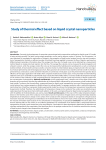
Study of thermal effect based on liquid crystal nanoparticles
Статья научная
Introduction. Currently, the development of composite systems doped with nanoparticles and based on liquid crystal (LC) media is being actively pursued. The latter, having unique properties, can be used to improve various LC devices. For this purpose, it is very important to investigate the mechanism of change in the properties of liquid crystal systems from the size and concentration of nanoparticles. Recently, a sufficient number of methods have been applied to measure the flow of liquid or gas based on different physical principles. Information about the average mass flow rate of a liquid or gas can be obtained by a measurement method based on steady-state heat injection into the flow. The average flow velocity can be measured by electromagnetic and ultrasonic sensors, while the average volume flow rate can be measured by hydrodynamic (aerodynamic) as well as mechanical turbine methods. In heat transfer and mass transfer, convective motion in a fluid medium plays an important role in the vast majority of natural phenomena and technological processes. Many processes of convective mass transfer and heat transfer in chemical, petrochemical, construction, nuclear and other industries are carried out in heat pipes. Up to the present time the question about efficiency of heat pipes application with bodies from composite materials also remains open. In the presented work the following objectives were set: to assemble an experimental setup to study the thermal effect (flow), to conduct studies of temperature change on the surface of the conductor of the compound based on nanoparticles of liquid crystals and viscosity of liquid crystals from the concentration of nanoparticles. Methods and Materials. In this experimental work, a heat flux acts in the region of the outer boundary of the conductor. Note that the redistribution of the thermal field is influenced by such processes as heat conduction and heat transfer. To observe the thermal effect, compounds based on liquid crystal nanoparticles were used. Nanostructured liquid crystal systems have a unique property as fluidity inherent in ordinary liquids. For opaque conductor walls, a method for determining the direction of heat flow is proposed. Earlier experimental studies have shown that temperature measurement is possible only by pyrometric method. Therefore, the redistribution of temperature change on the conductor flow surface was recorded using an optical pyrometer that perceives thermal (infrared) radiation. In this work, a compound based on liquid crystal nanoparticles, namely with the addition of cholesteryloleate, was used as a base. Results and discussion. In the course of the study, temperature dependences in the heat flow zone of the conductor in the absence and in the presence of liquid motion were experimentally obtained. Dependences of temperature change on the surface of the conductor with compounds based on nanoparticles of liquid crystals have been measured. Inhomogeneous redistribution of the thermal field is shown. The results of the study of the dependence of the viscosity of nematic liquid crystals on the concentration of nanoparticles are presented. Conclusion. The above data show that the thermal effect on the surface is not uniformly distributed. For visualization of the thermal effect, compounds based on nanoparticles of liquid crystals turned out to be more effective. A technique has been developed to determine the direction and calculate mathematically the magnitude of the liquid heat flux in the opaque conductor flow. It should be noted that the viscosity of liquid crystals changes when nanoparticles are coupled.
Бесплатно
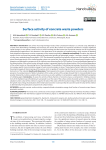
Surface activity of concrete waste powders
Статья научная
Introduction. One of the most large-tonnage wastes of the construction industry is a concrete scrap, obtained as a result of the dismantling of buildings and structures, the service life of which has reached its maximum or requires significant capital changes. In our opinion, works on the use of the resulting dust-like fraction are of particular interest. One of the promising methodological approaches in this direction is the observance of the principles of nanotechnology, which consists of obtaining finely dispersed components as active components of the created compositions. Materials and methods. Therefore, the objects of research in this work were fine powders obtained by mechanical grinding of lightweight (sample 1) and heavy (sample 2) concrete of a five-story residential panel house built in 1979. The elemental composition and specific surface area of the samples were determined, thermogravimetry of the studied powder systems was carried out, the surface tension of the experimental samples and the dispersion and polarization components of this indicator were determined by the OVRK method. A new methodological approach to the determination of the surface tension of powder systems is proposed, based on the determination of the functional dependence of the surface tension on the pressing force of the prototypes. The possibility of calculating macroenergy characteristics (atomization energy, specific mass atomization energy) of waste concrete samples is shown. These physicochemical indicators characterize the potential supply of internal energy of the system, which is capable of transforming into free surface energy during mechanical destruction of the material. Results and discussions. Thermogravimetric analysis of experimental concrete samples showed the presence of a residual amount of belite. Calculations of the surface activity of the samples showed that it is more preferable to use a powder obtained by crushing a sample of heavy concrete as an active additive in compositions capable of exhibiting the properties of a binding agent. Conclusions. To assess the activity of dusty fractions of concrete scrap as a component in binding compositions of the hydration type of hardening, it is proposed to use the value of the surface activity of powder systems as a criterion. The absolute numeric value of this criterion is equal to the ratio of the values of the free surface energy of the investigated powder and the specific mass energy of atomization of the initial waste concrete. It was found that for concrete waste the value of this criterion is determined by the polarization component of surface tension.
Бесплатно
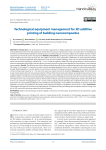
Technological equipment management for 3D additive printing of building nanocomposites
Статья научная
Introduction. The development of innovative approaches to digital equipment control that ensure the production of 3D building structures with high operational and technical-economic characteristics remains an urgent task. The handling and maintenance of technological equipment during the process of 3D-printing of construction objects do not always meet the modern requirements of technical systems management. Methods and materials. 3D-printing is based on the method of extrusion: molding of a building structure layer-by-layer with the addition and fairly rapid subsequent solidification of nanocomposite building materials. The resulting optimized nanocomposition must have the required rheology, which set the comb-like polycarboxylate esters with nanosteric repulsion at a distance of ≈ 11 nm. In order to organize a stable 3D-printing technology, it is also necessary to select the appropriate optimal fillers that provide the necessary physical, mechanical and operational characteristics to the hardened nanocomposite. Results. The effectiveness of three-dimensional printing calls for the coordinated operation of a construction-grade 3D-printer. In this regard, it is necessary to have concrete pumping equipment that is able to pump the initial nanocomposition through flexible pipelines at a certain speed. It is necessary to consider the influence of pressure and volume to increase the power of the concrete pump motor by 14–17%, and at the same tine reduce the level of vibrations. Discussion. Digital 3D-technologies reveal unique opportunities for innovative production of three-dimensional construction objects and engineering structures. Technological quality management of 3D-printing depends on the correct alignment of the printer mechanisms, and the reduction of defective products can be achieved by adjusting the molding parameters of building nanocomposites. The structure-forming curing of Portland cement nanocomposites is based on the formation of fractal structures of calcium hydrosilicate clusters with dimensions of 47–51 nm, that form nanoaggregates (125–132 nm), which gradually cement the fillers due to adhesive interactions. The high demand for the corresponding equipment only strengthens the advantages of 3D-additive technologies: its practical waste-free operation, low power consumption of 3D-printers, time reduction of design-to-completion process by 8–11 times. Conclusions. Technological managing of concrete pump equipment for 3D-additive printing of building nanocomposites reduces energy costs by 26–29%, and at the same time reduces the level of vibration.
Бесплатно
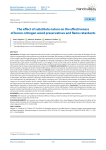
Статья научная
Introduction. Antiseptic and antipyretic treatment of wood is a prerequisite for its use in modern construction technologies. The use of boron compounds for these purposes has a significant advantage: the formation of stable chemical bonds between the molecules of the modifiers and the hydroxyl groups of the main components of wood (cellulose and lignin) due to boron-amine coordination on the surface of the modified material. By changing the chemical composition of boron-based modifiers, it is possible to control the properties of the surface of modified wood. In this regard, the aim of the study was to develop the optimal composition of boron-based modifiers that would provide long-lasting and effective protection against microorganisms and elevated temperatures while preserving the unique natural properties of pine wood. Methods and materials. The study was carried out using methods of thermal analysis, evaluation of the fire-retardant effectiveness of boron compounds, and determination of the fungus resistance of pine wood samples modified with boron compounds. Results. Boron compounds, in which one hydroxyl group at the boron atom is replaced by a phenyl radical, showed higher effectiveness against mold and wood-destroying fungi and provided the second group of fire protection effectiveness at lower concentrations compared to boron-nitrogen compounds with three hydroxyl groups at the boron atom. Discussion. The introduction of a phenyl radical into boron-nitrogen compounds sharply increases their effectiveness as antiseptics and flame retardants, allowing a fivefold reduction in working concentration without loss of protective properties. Low concentrations of phenylborates (5–10%) reduce processing costs. The minimum concentration of modifiers minimizes the impact on the natural structure of the material. Stable coordination bonds between boron-nitrogen compounds and cellulose and lignin prevent the leaching of reagents. Phenylborate-based compositions are optimal for the comprehensive protection of lignocellulosic materials in construction in accordance with environmental requirements. Conclusion. The study proved that the nature of the substituent in boron compounds is a decisive factor in their effectiveness. Phenyl-containing boron-nitrogen compounds combine high biocidal activity, thermal stability, and fire protection at minimum concentrations, offering an economically and environmentally sustainable solution for wood modification.
Бесплатно
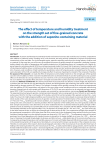
Статья научная
Introduction. To restore and develop the Solovetsky Islands road network concrete slabs could be used. Currently, compositions with additives of industrial waste, including micro- and nanoscale, are being actively introduced to improve the performance characteristics of the road slabs. For the Arkhangelsk region, saponite-containing waste from the mining industry could be used as a material. At the same time, one of the ways to accelerate the process of gaining strength of composites is steaming. However, studies related to the effect of temperature and humidity treatment on the hardening process of a composite with a highly dispersed saponite-containing material (SCM) have not been previously studied. It is known that the process of moisture sorption with a finely dispersed additive allows controlling structure formation during concrete hardening, improving its operational characteristics. However, under conditions of high humidity, the quantitative content of tempering water, calculated based on the value of water absorption of the SСM, can significantly change and affect the process of gaining the strength of the composite. Therefore, the purpose of this research is to study the effect of temperature and humidity treatment on the strength gain of fine-grained concrete with the addition of SCM. It has been established that the accelerated method of concrete hardening has only a positive effect on the formation of a strong and dense structure. However, in the case of using highly dispersed saponite-containing material as an additive, the opposite effect (decrease in strength) associated with sorption properties and features of its structure can be observed. Methods and Materials. The SCM recovered from the recycled water was dried to constant weight and dispersed on a planetary ball mill. Particle size was determined by dynamic and electrophoretic light scattering, and specific surface area was determined by nitrogen sorption (BET theory). The strength of samples of fine-grained concrete of the control and experimental (with the addition of SCM) compositions was gained in two ways: under normal conditions and by an accelerated method using steaming. Strength tests of cube samples with dimensions of 70×70×70 mm were carried out on an automatic test press according to GOST 10180. The microstructure of the samples was examined by scanning electron microscopy. Results and Discussion. The separated, dried and ground saponite-containing material (powder) had an average particle size of 445±40 nm and a specific surface area of 50 670±10 m2/kg. In continuation of the studies, control (FGC) and test samples of fine-grained concrete (FGCscm) were made. The amount of a highly dispersed additive was introduced into the concrete mixture based on previously obtained results of kinetic studies of the water absorption process of saponite-containing material. The determination of the strength characteristics of 1-FGC and 1-FGCscm, hardening under normal conditions, was carried out on day 28. Samples of 2-FGC and 2-FGCscm, a day after sealing with water, were placed in a steaming chamber. After the expiration of the holding time, they were gradually cooled and their strength characteristics were determined. It has been established that the accelerated method of gaining strength of finegrained concrete, by steaming, has a positive effect only on control samples. For a composite with the addition of SCM, temperature and humidity treatment has the opposite effect. Thus, the dynamics of strength gain of 1-FGC and 1-FGCscm are of the same type. At the initial moment of time, an active site of strength gain is observed, but on day 7, the compressive strength of the samples of the experimental composition is 40% higher than that of the control one. At the accelerated curing method in the first two hours (isothermal heating stage), an active strength increase was observed in 2-FGC and 2-FGCscm. The subsequent curing of the control specimens has a linear dependence with a gradual increase in strength to the design strength in six hours. For 2-FGCscm, after two hours of steaming, the strength sharply begins to decrease, and after six hours – visible destruction of the concrete structure occurs. Consequently, prolonged temperature and humidity exposure of concrete with highly dispersed SSM admixture leads to a decrease in the strength characteristics of the specimens. Most likely, it is connected with moisture oversaturation of the composite structure. Therefore, in continuation of the research, electronic photographs were taken of the microstructure of concrete after three hours of holding in the steaming chamber. Thus, the microstructure of 2-FGCscm is mainly represented by spongy particles, and the number of formed needle-like (tobermorite crystals) – decreased significantly, compared to the control.
Бесплатно
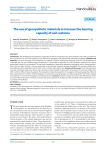
The use of geosynthetic materials to increase the bearing capacity of soil cushions
Статья научная
Introduction. The development of Kazakhstan's megacities has led the construction sites to the territories with weak, macroporous soils. Construction on such soils requires a set of measures to strengthen and improve their mechanical properties. Methods and Materials. The article discusses the development of a method of surface hardening by replacing weak soil. This development is associated with the use of different types geosynthetics. The principles of operation of a soil foundation reinforced with various geosynthetic materials are considered. The mechanical properties of geotextiles, geogrids and geogrids used to harden embankment soils have been studied. A new test procedure for geosynthetic materials has been developed. This procedure differs from the traditional method specified in GOST 32491 with a constant deformation rate. Results and Discussion. Tests of geosynthetic materials in kinematic mode have shown that a decrease in tensile strength is observed for all materials. The reduction ranges from 28% to 42% for different types of geogrids. The elongation at break decreased for the hexagonal and biaxial geogrid by 8.6% and 30%, respectively. An increase in relative elongation was noted for a uniaxial geogrid. According to geotextile, the tensile strength decreased by 15.7%, and the elongation increased by 26.5%. Conclusion. Research results have shown the effectiveness of the recommended reinforcement methods to increase the bearing capacity of the bases and the possibility of their application in various regions of Kazakhstan.
Бесплатно
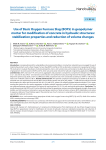
Статья научная
Introduction. Increasing demands for sustainability and environmental safety in construction materials have encouraged the use of industrial by-products such as Basic Oxygen Furnace Slag (BOFS) and fly ash (FA) as alternative components in geopolymer binders. This study aims to evaluate the physico-mechanical properties, micro- and nanostructure, and resistance to alkali-silica reaction (ASR) of geopolymer mixtures based on BOFS and FA, which are particularly relevant for hydraulic engineering applications. Methods and Materials. BOFS and Class F FA were used as aggregates and pozzolanic components. Compressive strength was measured at 3, 7, 28, and 56 days. Micro- and nanostructural analyses were performed using Scanning Electron Microscopy (SEM), Energy Dispersive Spectroscopy (EDS), and X-ray Diffraction (XRD). Expansion tests were conducted according to ASTM C 1260 in both water and 1 M NaOH solution at 80 °C. Results and Discussion. The optimal compressive strength (up to 50 MPa at 28 days) was achieved with 75% replacement of sand by BOFS and an alkali activator ratio of Na2SiO3/NaOH = 1. SEM and EDS analyses revealed the formation of a dense gel-like structure with N-A-S-H and CaCO3 phases. All samples exhibited expansion below 0.1% in water, meeting the criterion for non-reactive aggregates. In alkaline solution, expansion reached 0.25% in some compositions. A correlation was observed between microstructure, the content of reactive phases (Si, Al, Ca), and mechanical performance. Conclusion. The results demonstrate that BOFS and FA can be effectively utilized in geopolymer mixtures, providing adequate strength, dimensional stability, and ASR resistance. Carbonation curing and proper selection of alkali activators enhance BOFS stabilization and reduce its expansive behavior. These findings support the potential use of such mixtures in sustainable and durable construction systems, especially for hydraulic structures.
Бесплатно

